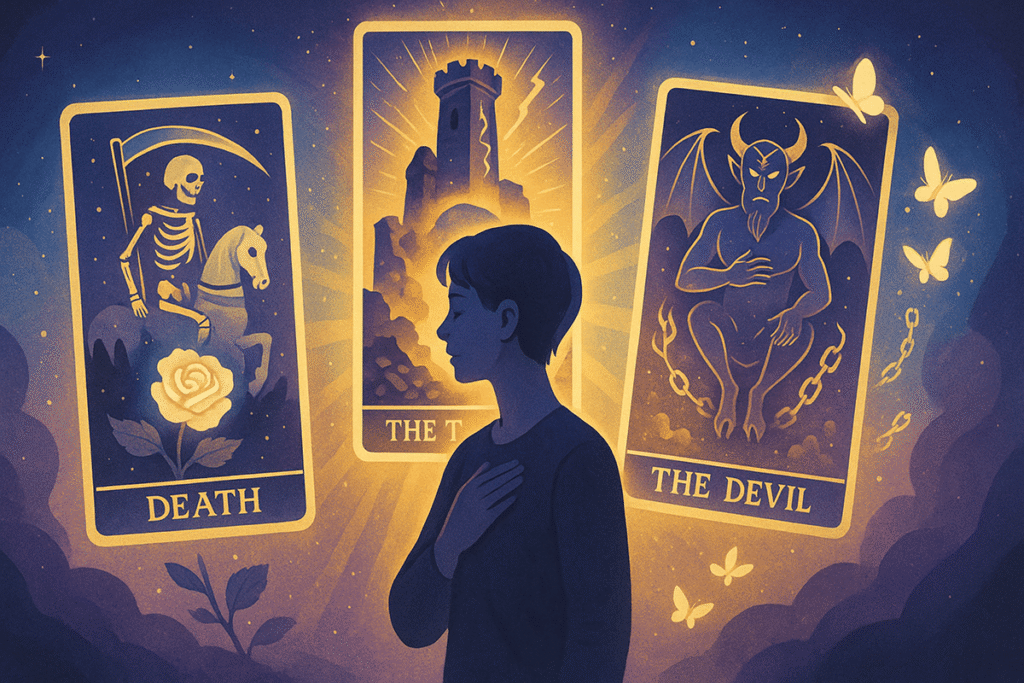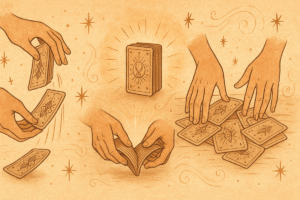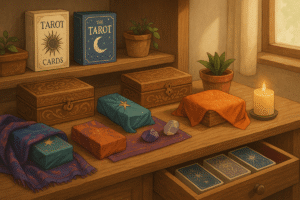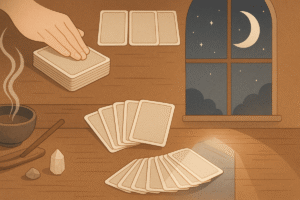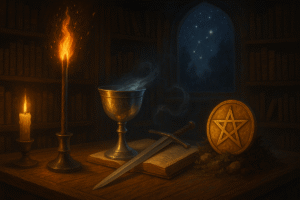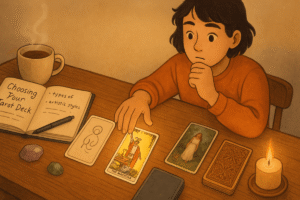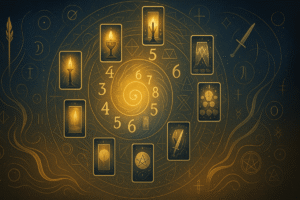Table of Contents
When people first encounter tarot, certain cards make them uncomfortable. I’ve seen it happen countless times. Someone shuffles a deck, pulls a card, and their face changes. The Death card appears, or The Tower, or The Devil. There’s an immediate tensing, a visible worry. It’s understandable, really. These cards carry heavy imagery and ominous names that seem to promise disaster.
But here’s what I think gets missed in that initial reaction. These supposedly frightening cards aren’t warning signs or cosmic punishments. They’re invitations. Each one asks you to look at something you might prefer to avoid, and in that uncomfortable looking, there’s often the beginning of something genuinely valuable.
The truth is, tarot works best as a psychological mirror. The cards that make us most uncomfortable are frequently the ones pointing toward areas where we’re ready for growth, even if we don’t feel ready. They reflect back the changes we sense coming, the structures we know aren’t working, the patterns we’ve outgrown but still cling to.
This post will walk through the cards that earn the “scary” label most often. We’ll explore what they’re actually reflecting and how you might use them as tools for honest self examination rather than sources of fear.
Why Certain Cards Feel Frightening
Before we look at specific cards, it helps to understand why some imagery feels more loaded than others. Tarot emerged from a particular historical and cultural context, one that used dramatic symbolism to convey psychological and spiritual concepts. Death, destruction, bondage. These are archetypal images that trigger something primal in most of us.
The medieval and Renaissance artists who shaped tarot’s visual language weren’t subtle. They wanted cards that would stop you, make you pay attention, force you to sit with uncomfortable truths. In that sense, the unsettling nature of certain cards is intentional. They’re designed to break through our everyday defenses.
Perhaps that’s actually useful. We spend so much energy maintaining our narratives about who we are and how our lives should unfold. A card that disrupts that narrative, even briefly, creates a moment of openness. In that moment, you might see something you’ve been avoiding. You might ask a question you’ve been afraid to ask.
The discomfort isn’t the problem. The discomfort is often pointing toward exactly where the real work needs to happen.
Death as a Mirror of Necessary Endings
Let’s start with the most obvious one. The Death card shows a skeleton in armor, often riding a horse, carrying a black flag. Sometimes there are fallen figures, sometimes a rising sun in the background. The imagery is stark and final.
And yet, this card almost never means literal death. I know that’s what everyone wants to know first, and the answer is no. What it does mean requires sitting with a different kind of ending.
Think about the structures in your life right now. Your job, your relationships, your daily routines, your beliefs about yourself. Which of these feel like they’re in a natural conclusion phase? Not failing, necessarily, but completing. There’s a difference between something breaking and something finishing its useful cycle.
The Death card asks you to identify what’s ready to end. What needs to end so something else can begin. This might be a phase of life, a way of thinking, a role you’ve been playing that no longer fits. The transformation it points toward isn’t violent or cruel. It’s organic, even if it’s uncomfortable.
When this card appears in a reading, the reflective question isn’t “what terrible thing will happen?” It’s more like “what am I holding onto that’s already gone?” or “what transition am I resisting because I’m afraid of what comes next?”
There’s something about human nature that makes us cling to the familiar, even when the familiar has stopped serving us. We’ll maintain a dying friendship for years rather than acknowledge it’s over. We’ll stay in careers we’ve outgrown because the alternative feels like freefall. The Death card reflects that clinging back to us and asks, gently but firmly, whether we’re ready to let go.
The transformation it offers isn’t always comfortable, but I think there’s a certain relief in it too. Something in us knows when a chapter has ended. The Death card gives us permission to acknowledge that knowledge.
The Tower and the Collapse of False Structures
If Death is about organic endings, The Tower is about sudden ones. The card typically shows a tower struck by lightning, figures falling from its windows, destruction and chaos. It’s dramatic imagery, and it tends to provoke even stronger reactions than Death.
Here’s what I’ve noticed about The Tower in practice, though. It appears when something in your life is built on shaky ground, and some part of you already knows it. The lightning strike isn’t random. It hits the structures that were never as solid as you wanted to believe.
This could be a relationship built on illusions rather than honest communication. A career path chosen to please others rather than reflect your actual interests. A self image maintained through constant performance and exhaustion. The Tower asks what you’ve constructed that can’t actually hold.
The card’s energy feels violent because dismantling these false structures often is violent. Not in a physical sense, but emotionally and psychologically. When something you’ve invested in heavily falls apart, there’s grief and disorientation. You might have spent years building that tower. Watching it crumble hurts.
But the reflective question The Tower offers is worth sitting with. What would be left if everything that isn’t truly solid fell away? What parts of your life are built on authentic foundations, and which parts are held up by denial, obligation, or fear?
I think the most unsettling aspect of The Tower is that it suggests we don’t always get to control the timing of these revelations. Sometimes the structure collapses before we feel ready. Sometimes the truth comes out before we’ve prepared for it. The card reflects back our lack of control, which is perhaps the most frightening thing it could show us.
Yet there’s a strange liberation in it too. The Tower clears ground. After the collapse, you can rebuild on something more honest, more stable. The chaos is temporary. The clearing it creates might be exactly what you needed, even if you didn’t want it.
The Devil and the Examination of Personal Bondage
The Devil card shows a horned figure, often with two humans chained at its feet. The imagery draws on Christian demonology, but the psychological message is more subtle and perhaps more challenging than simple evil.
Look closely at most versions of this card. The chains around the figures’ necks are loose. They could remove them if they chose to. That detail changes everything about what the card reflects.
The Devil isn’t about external evil or cosmic punishment. It’s about the patterns you participate in that limit you. The addictions, the toxic relationships, the self destructive behaviors, the fear based decisions. The things you could walk away from but don’t, because some part of you gets something from staying chained.
This might be the most uncomfortable card to sit with because it removes the comfort of victimhood. When The Devil appears, the question it asks is “what are you choosing that you pretend you’re not choosing?” or “what would you have to face about yourself if you removed these chains?”
Maybe it’s a relationship that’s clearly unhealthy but provides a familiar kind of drama you’ve learned to mistake for passion. Maybe it’s a substance or behavior you use to avoid feeling difficult emotions. Maybe it’s a set of limiting beliefs about yourself that you’ve held so long they feel like truth rather than choice.
The card reflects back our complicity in our own limitations. That’s confronting. It’s easier to believe we’re trapped by circumstances or other people than to acknowledge our own participation in the pattern.
I think what makes The Devil particularly valuable as a reflective tool is that it invites radical honesty. Not self judgment or shame, but clear seeing. Can you look at the chains you’re wearing and acknowledge that you’ve chosen them, consciously or not? Can you examine what you’re getting from staying bound?
Sometimes what we get is the comfort of the known. Sometimes it’s an identity we’ve invested in. Sometimes it’s a way of avoiding responsibility or risk. The Devil doesn’t judge these choices, but it does make them visible.
And once they’re visible, once you can see your own participation, the possibility of a different choice emerges. The chains are loose. They always were. The question is whether you’re ready to remove them, and what you’ll have to face when you do.
Working With Difficult Cards as Growth Tools
So how do you actually use these cards when they appear? How do you move from that initial flutter of anxiety to something more useful?
First, notice the reaction itself. What specifically makes you uncomfortable about the card? Is it the imagery, the associations, or something deeper? Sometimes our strongest reactions point toward our most defended places.
Then, shift from prediction to reflection. Instead of asking “what bad thing will happen?” try questions like “what transition am I sensing?” or “what structure feels unstable?” or “what pattern am I ready to examine?”
Journaling works well with these cards. Pull one intentionally, sit with it for a while, and write whatever comes up. Don’t edit or judge. Let the card act as a prompt for honest self examination.
You might also try reframing the card’s message in your own words. What would The Tower be saying if you stripped away the dramatic imagery? Perhaps something like “it’s time to be honest about what’s not working.” That’s less frightening than lightning and collapsing buildings, but it carries the same essential invitation.
The Unexpected Gift of Discomfort
Here’s something I’ve come to appreciate over time. The cards that initially scared me are often the ones I’m most grateful for now. Not because I enjoy discomfort, but because they pointed toward necessary changes I was avoiding.
The Death card appearing before I left a career that was draining me. The Tower showing up when a relationship was crumbling and I was still pretending everything was fine. The Devil reflecting back patterns I needed to acknowledge before I could change them.
These weren’t comfortable experiences. But the cards weren’t causing the discomfort. They were reflecting it back to me, making visible what I already sensed but didn’t want to see.
That’s what the scary cards do, really. They show us what we already know but haven’t admitted. They reflect the transitions we’re ready for even when we don’t feel ready. They ask us to look at what we’d rather avoid.
And maybe that’s exactly what we need sometimes. Not prediction or reassurance, but an honest mirror. A question we can’t easily dismiss. An invitation to grow, even when growth feels frightening.
The next time you pull one of these cards and feel that familiar tension, try sitting with it a bit longer. Ask what it’s reflecting rather than what it’s predicting. See if the discomfort might be pointing toward something valuable, a readiness you didn’t know you had, a transition that’s already beginning whether you acknowledge it or not.
The scary cards aren’t omens. They’re mirrors. And sometimes, what we most need to see is exactly what we’ve been most afraid to look at.
Frequently Asked Questions
Can these cards actually predict something bad will happen to me?
These cards don’t predict fixed future events. They reflect patterns, transitions, and inner processes that are already happening or ready to happen in your life. When Death, The Tower, or The Devil appears, they’re showing you psychological dynamics and choices rather than predetermined outcomes. The future remains open to your choices and responses.
What should I do if I pull one of these cards and feel scared?
Take a breath and step back from the reading if you need to. Notice what specifically triggers your fear, as this often points to something important. When you’re ready, shift from asking “what bad thing will happen” to “what is this reflecting about my current situation?” Journaling about the card or returning to it later with fresh perspective can help transform initial anxiety into useful insight.
Do The Tower and Death always mean something is ending?
The Tower and Death both relate to endings, but with different energies. Death reflects natural completion cycles and organic transitions, like outgrowing a phase of life. The Tower points to structures built on unstable foundations that can’t hold anymore. Neither promises catastrophe. They’re asking you to look honestly at what’s already shifting or ready to transform, rather than announcing disasters from nowhere.
Is The Devil card telling me I’m a bad person?
Not at all. The Devil reflects patterns of limitation you participate in, like unhealthy relationships, addictive behaviors, or self limiting beliefs. The key detail in most Devil cards is that the chains are loose. You could remove them if you chose to. This card asks you to examine what you’re getting from staying bound rather than judging you for being there. It’s an invitation to honest self examination, not moral condemnation.

